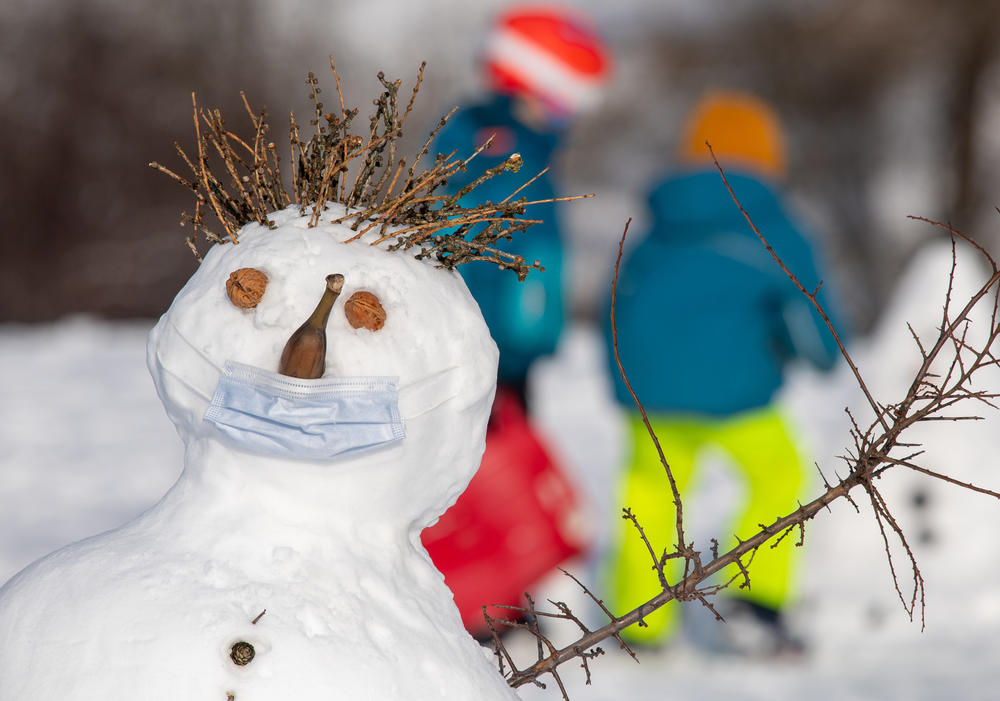Section Branding
Header Content
Coronavirus FAQ: What's the risk of catching omicron outdoors?
Primary Content
Each week, we answer frequently asked questions about life during the coronavirus crisis. If you have a question you'd like us to consider for a future post, email us at goatsandsoda@npr.org with the subject line: "Weekly Coronavirus Questions." See an archive of our FAQs here.
Studies conducted prior to omicron show that being outside greatly reduces your risk of infection with the coronavirus. One review of studies concluded that the odds of indoor transmission is almost 19 times higher than outdoor transmission. And in a study of 64 college football games during the 2020 season involving 1,190 athletes, researchers at Texas A&M University found zero spread of COVID during game play based on three postgame PCR tests over the course of a week — likely because of the outdoor setting and short duration of close contact, experts say. (Of course, football games have been postponed this season because of COVID outbreaks, but the study's authors believe that players were more likely spreading it in locker rooms and other shared indoor spaces.)
Outdoor airflow has done a good job dispersing pathogens.
But does omicron play by the same rules?
"From a virus standpoint, there's no indication that omicron is behaving differently [in outdoor settings]," says Dr. Preeti Malani, an infectious disease professor at the University of Michigan who co-authored an editorial on the research on football teams.
"That doesn't mean [transmission is] impossible if you're packed together in a place that's only sort of open air and if people are sharing food or kissing or drinking. But if it's a casual interaction outside, even if it's relatively crowded, I'm comfortable not having a mask on. And at this stage of the pandemic, we have to find ways to do things that are meaningful to us. It's nice to see people's expressions and feel a sense of normalcy."
And playing outdoors, Malani notes, is great for kids — building snow structures and sledding in parts of the country that are now shivering in winter temperatures.
Of course, omicron is the most transmissible variant yet. That, combined with the sheer volume of cases, could mean that there could be more cases of outdoor transmission, says Dr. Jill Weatherhead, assistant professor of adult and pediatric infectious diseases at Baylor College of Medicine. So some people may want to mask up in certain outdoor situations. But that shouldn't cause you to lose sight of the advantages of socializing outdoors, she adds.
"Being outdoors continues to provide another layer of protection because of the ventilation," Weatherhead explains. (The other layers are vaccination, masks and physical distancing.)
"So the safest place you can be [with other people] is still going to be outdoors," she says.
If your own risk tolerance is low, certain outdoor situations could call for masking up. Earlier studies showed that the fewer cases of outdoor transmission almost always occurred during prolonged, close contact. For example, talking face-to-face with someone who is unmasked and very, very close to you is risky no matter where you are, especially if it's for a prolonged period of time.
"It can happen outside," says Dr. Don Milton, an infectious disease aerobiologist at the University of Maryland School of Public Health.
Still, he says, you have to be close to the infected person or downwind of them. "That gentle breeze outdoors is generally safer" than indoors, he says. "The air movement [outdoors] is more random and the virus won't build up."
And yes, that holds true for omicron, he believes. Although it makes sense that people would worry about getting a more contagious variant outdoors, it's likely that the current surge in cases doesn't have anything to do with outdoor spread.
Preliminary research, including a small study by Milton's lab, suggests that people infected with omicron don't breathe out higher viral loads than people infected with delta. And people who are vaccinated likely carry less infectious virus particles than people who are not.
So if you find yourself worrying about not being able to distance yourself in a crowded outdoor situation with people of unknown vaccination status, slip a mask on.
Just keep in mind that risk is a continuum.
"Slipping on the ice or getting in an accident on the way [to an outdoor rendezvous] is probably more likely than getting COVID outside," Malani says.
However, if you live in a cold locale as she does, you may want to leave your mask on for warmth. Not only does it keep your cheeks warm, but who wants to take their gloves off to fuss with a mask in sub-freezing temps?
Sheila Mulrooney Eldred is a freelance health journalist in Minneapolis. She has written about COVID-19 for many publications, including The New York Times, Kaiser Health News, Medscape and The Washington Post. More at sheilaeldred.pressfolios.com. On Twitter: @milepostmedia.
Copyright 2022 NPR. To see more, visit https://www.npr.org.

